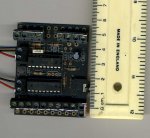After several years of very reliable use we have today started shipping updated versions of the CHI030 and CHI035 18 pin projects boards.
The CHI030 is also used in the PICAXE-18M2 starter pack (AXE002U).
The new boards can be easily identified as they have an 'A' suffix printed on the board next to the download socket (e.g. CHI030A).
They are physically the same size as before, so can still be used in projects originally designed for the older versions.
The main updates are almost all enhancement requests from our users:
www.rev-ed.co.uk/docs/chi030a.pdf
www.rev-ed.co.uk/docs/chi035a.pdf
The CHI030 is also used in the PICAXE-18M2 starter pack (AXE002U).
The new boards can be easily identified as they have an 'A' suffix printed on the board next to the download socket (e.g. CHI030A).
They are physically the same size as before, so can still be used in projects originally designed for the older versions.
The main updates are almost all enhancement requests from our users:
- Labelling of i/o updated to match PICAXE-18M2 i/o labelling system
- Added row of pads between PICAXE and darlington buffer to allow easy access to portB pins for logic level interfacing (e.g. use with AXE033 Serial LCD).
- Added optional pads to use a 78L05 regulator on the board if desired
- Pull down resistors on inputs C.0 and C.1 are now fitted by default
- Reset switch is no longer fitted by default, as not required by 18M2
- CHI035A now uses 'logic level input' FETs with a pull-down resistor
- Added mounting holes to assist mounting into enclosures
www.rev-ed.co.uk/docs/chi030a.pdf
www.rev-ed.co.uk/docs/chi035a.pdf

